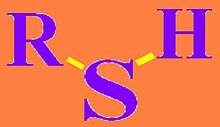Structural Biochemistry/Organic Chemistry/Organic Functional Group/Sulfhydryl
< Structural Biochemistry < Organic Chemistry < Organic Functional GroupGeneral Overview
A sulfhydryl is a functional group consisting of a sulfur bonded to a hydrogen atom. The sulfhydryl group, also called a thiol, is indicated in chemistry nomenclature by "-thiol" as a suffix and "mercapto-" or "sulfanyl" as a prefix. Thiols have great affinity for soft metals. Sulfhydryls play an important role biochemistry, as disulfide bonds connect necessary amino acids together for functional purpose in secondary, tertiary, or quaternary proteins structures.
Several Important Roles in Biochemistry
Sulfhydryl groups can be found in the amino acid cysteine. When two cysteine residues are in close proximity to each other, they can form a disulfide bridge also called cystine. The formation of a disulfide bond is an example of a post translational modification. It can be helpful to the structure of proteins, but it can make it difficult to accurately determine the sequence of a protein through the technique of Edman Sequencing. Disulfide bridges often play important structural and functional roles in proteins. Their hold are crucial in the formation of many tertiary structures of proteins. Extracellular proteins usually contain disulfide bonds whereas intracellular proteins usually lack disulfide bonds. These disulfide bonds can be broken with the addition of beta mercaptoethanol. Beta mercaptoethanol reduces the disulfide bonds back into their sulfhydryl form. It was found by Christian Anfinsen that proteins denatured by beta mercaptoethanol in urea will spontaneously reform its disulfide bonds if trace amounts of beta mercaptoethanol are present. This reformed protein was found to be fully functional. If the protein was reformed in the absence of urea, it was found that the function was greatly reduced. This is due to the fact that the wrong disulfide bonds were formed and the amino acid became "scrambled."

Structure
The C-S bond in thiols are 180 picometers in length, and the C-S-H bonds are at a 90˚ angle, similar to alcohols. Their main cohesive forces are Van Der Waals interactions, and they have lesser electronegativity than most Hydoxyl groups, making them less polar.
Reactions
Thiols can be easily oxidized, and thiolates act as potent neucleophiles.
S-Alkylation
The conjugate bases of thiols can be alkylated to give thiolethers.
RSH + R'Br + base → RSR' + [Hbase]Br
Redox
Thiols, in the presence of a base, are oxidize to give an organic disulfide.
2 R–SH + Br2 → R–S–S–R + 2 HBr
Thiols can be oxidized by more powerful reagents such as sodium hypochlorite to yield sulfonic acids.
R–SH + 3H2O2 → RSO3H + 3H2O
Thiols can also undergo thiol-disulfide exchange.
RS–SR + 2 R'SH → 2 RSH + R'S–SR'
Grignard reagents can react with sulfur to make thiolates.[1]
RLi + S → RSLi RSLi + HCl → RSH + LiCl
References
1. Berg, Jeremy M. (2007). Biochemistry, 6th Ed., Sara Tenney. ISBN0-7167-8724-5. 2. Campbell, Neil A. Biology. 7th ed. San Francisco, 2005. 3. E. Jones and I. M. Moodie (1990), "2-Thiophenethiol", Org. Synth.; Coll. Vol. 6: 979
- ↑ E. Jones and I. M. Moodie (1990), "2-Thiophenethiol", Org. Synth.; Coll. Vol. 6: 979